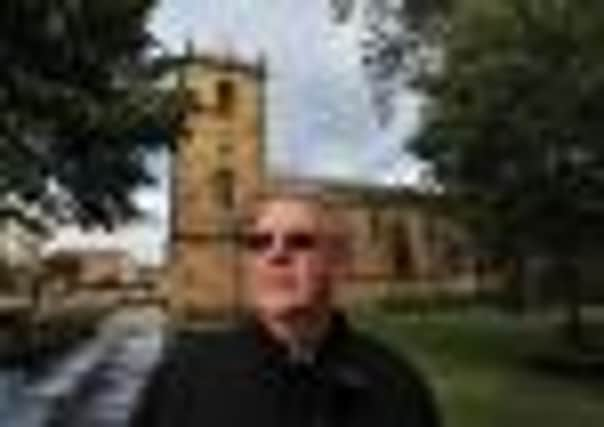Malcolm Barker: Pillagers in the House of God... what a testament to today’s twisted society


A Book of Common Prayer was shelved there, a very old one, for it included an Order of Service thanking God for James I’s deliverance from the Gunpowder Plot of 1605.
Turning its thin pages was a reminder of our history, for it could have been in the church for a good 300 years, and it awakened the past more effectively than any of Mr Shipley’s history lessons at Whitby Grammar School.
Advertisement
Hide AdAdvertisement
Hide AdLooking round, there were other historical prompts. The Cholmley Pew, balanced arrogantly across the chancel arch on twisted columns like white barley sugar, recalled the proud family who bought the Abbey lands after the Dissolution.
A carved oaken board bore the names of many Whitby sailormen lost during the Great War. In the entrance was a curious memorial to the victims of the 1861 lifeboat disaster, in which all but one of the entire crew perished.
This is the way of our churches. In addition to gathering to themselves an atmosphere of peace and holiness, as if sanctified by the prayers of generations, they acquire in their fabric, their furnishings and their memorials a record of times and people sometimes stretching back 1,000 years.
Many of us, including those who have turned their backs on Christ and His teaching, still hold their local church in high regard as a hub of their community.
Advertisement
Hide AdAdvertisement
Hide AdAlas, the buildings are under attack. Churches that survived Viking raids, invasions by the Scots, Henry VIII’s Reformation, Puritan zealots of the Commonwealth, and Victorian “improvements” are being ruthlessly pillaged.
The figures revealed by the Yorkshire Post yesterday are alarming, with 2,900 insurance claims for thefts from Anglican and Methodist churches in Yorkshire since 2007. Already this year, 500 claims have been registered.
This is a tsunami of crime, threatening to sweep our churches away, and with them much of our precious heritage.
All sorts of things get stolen: oak gates (All Saints’, Barwick- in-Elmet), a stone head (St Andrew’s, Newton Kyme), a door knocker and paving stones (St John the Baptist, Adel, Leeds), four silver home Communion sets (St John’s, Bilton, Harrogate); but in the main the thieves are after lead. They remove it in large quantities, half a ton from Christ Church, Woodhouse, Sheffield, and £3,000 worth from St Mary’s, Kelbrook, in the Skipton Deanery. Yorkshire’s oldest church, St Peter’s at Conisbrough, has suffered grievously, with thefts in 2009 and 2010, when five panels of lead measuring 10 feet by 15 were taken from the roof in a single night.
Advertisement
Hide AdAdvertisement
Hide AdOne of the saddest stories comes from across the county boundary in Westmoreland where, in the upland community of Shap, a church has stood since 750 AD, with the first stone structure going up in 1150. It was rebuilt in Victorian times, but the Norman arcade was retained.
Carlisle Crown Court heard in July that Shap’s church, dedicated to St Michael, may never be used again. Before the court was a 25-year-old villager, whose parents live just down the road from the church. Six times he went to St Michael’s at night in his mother’s car, stripping lead off the roof.
He sold it at an Appleby scrapyard, claiming the metal, all 30 hundredweights of it, had come from an uncle’s house.
Three years ago, proud villagers re-roofed their beloved St Michael’s at a cost of £70,000, and now another £30,000 is needed to make good the depredations of a wretched and useless young man.
Advertisement
Hide AdAdvertisement
Hide AdSuch thieves have an advantage because churches are usually set in their own grounds, and are sometimes shielded from view by trees. It is sad indeed to think that the ancient churchyard yews may now be a shield for villainy.
However, lead flashing, which is the usual target, is heavy and difficult to move. Manhandling it down a ladder from a roof in the darkness of night is no easy task, and some kind of vehicle must be used to take it away.
The activity involved would not have escaped an old-fashioned village bobby. Such stalwarts may not be keeping watch today, but it is a great mystery why the police seem incapable of prosecuting the fences who buy the stolen lead and sell it on.
Instead they make the usual requests to the public to be vigilant, and in November the West Yorkshire force will be participating in a “Lead Theft Reduction Seminar” with the clock specialists Smiths of Derby, who have developed a range of security systems for churches. The police are also setting up across the county “Faithwatch” schemes similar to one already operating in Leeds.
Advertisement
Hide AdAdvertisement
Hide AdThese initiatives are all very well, but what’s needed is some traditional policing. Lacking such protection, we can only pray that our churches may be spared.
We are taught that God will pardon the repentant thief, but those who struggle to keep our churches alive may find it difficult to direct loving thoughts at them that trespass against them so determinedly and persistently, and with such bitter consequences.
Too often it seems the devil is on the roof, and not down below. Forgiveness comes hard when rain cascades on your pew from a hole riven in the church roof.
Malcolm Barker is a former editor of the Yorkshire Evening Post.